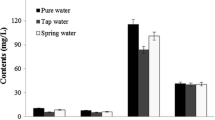Abstract
Sensory characteristics and chemical properties of 9 commercial dongchimi (Korean watery radish kimchi) liquid varieties were investigated using sensory descriptive analysis and instrumental analyses. Dongchimi was analyzed for pH, titratable acidity, soluble solids, salinity, organic acids, sugars, ethanol, and amino acids. Arginine, glutamic acid, and proline were the key amino acids. Lactic acid was the main organic acid in mature dongchimi. Based on sensory descriptive analysis, 4 appearances, 10 odors, 5 flavor/taste, and 3 mouthfeel sensory attributes were developed. Descriptive sensory and instrumental results showed that a white hue was associated with garlic, leek, and chili odors, glutamic acid, acetic acid, lactic acid, ethanol, and mannitol. Samples with a yellow hue were associated with turbidity, moldy and yeast odors, salty taste, fructose, glucose, and malic acid.
Similar content being viewed by others
References
Cho WK. A historical study of Korean traditional radish kimchi. Korean J. Food Culture 25: 428–455 (2010)
Um DH, Chang HG, Kim WJ. Effect of pasteurization on quality characteristics of low salt dongchimi juice. Korean J. Food Sci. Technol. 29: 730–736 (1997)
Oh HI, Kwon SM, Shin TS. Changes in chemical and sensory characteristics of dongchimi juice during fermentation with the addition of Panax ginseng C.A. Meyer. Korean J. Ginseng Sci. 20: 307–317 (1996)
Lee JJ, Jung HO, Lee MY, Chang HC. Development of sun-dried salt kimchi beverage. Korean J. Food Preserv. 17: 800–806 (2010)
Ann YG. Dongchimi fermentation for drinks. Korean J. Food Nutr. 14: 46–51 (2001)
Ko EJ, Hur SS, Park M, Choi YH. Studies on the optimum fermenting conditions of dongchimi for production of ion beverage. J. Korean Soc. Food Sci. Nutr. 24: 141–146 (1995)
Kim HR, Kim YS, Jang MS. Physicochemical properties of naengmyon broth added with dongchimi of different fermentation. Korean J. Food Cook. Sci. 20: 54–62 (2004)
Jeong SH, Jung JY, Lee SH, Jin HM, Jeon CO. Microbial succession and metabolite changes during fermentation of dongchimi, traditional Korean watery kimchi. Int. J. Food Microbiol. 164: 45–53 (2013)
Kim SY, Choi EH. Isolation of lactic acid bacteria from dongchimi juice and lactic acid fermentation using mixed fruit and vegetable juices. Food Sci. Biotechnol. 10: 76–83 (2001)
Park YS, Lee JY, Kim YS, Shin DH. Isolation and characterization of lactic acid bacteria from feces of newborn baby and from dongchimi. J. Agr. Food Chem. 50: 2531–2536 (2002)
Park YH, Jung LH. Consciousness and sensory characteristics on commercial kimchi. Korean J. Human Ecology 9: 85–92 (2006)
Yoon HM, Um KW. Sensory evaluation of kimchi using two ethnic groups. Korean J. Food Sci. Technol. 23: 755–758 (1991)
Chambers E IV, Lee JH, Chun SS, Miller AE. Development of a lexicon for commercially available cabbage (baechu) kimchi. J. Sens. Stud. 27: 511–518 (2012)
Lee SJ, Kwon YH, Kim HR, Ahn BH. Chemical and sensory characterization of Korean commercial rice wines (yakju). Food Sci. Biotechnol. 16: 374–380 (2007)
Lee MR, Lee HS. A study on the flavor compounds of dongchimi. Korean J. Food Cook. Sci. 6: 1–8 (1990)
Schlich P. Uses of change-over designs and repeated measurements in sensory and consumer studies. Food Qual. Prefer. 4: 223–235 (1993)
Sun H, Ye T, Wang L, Chen Y, Li B. Antioxidant activities of chick embryo egg hydrolysates. Food Sci. Nutr. 2: 58–64 (2014)
Kim JH, Choi JR, Kim MY. Sensory characteristics of pork sausages with added citrus peel and dried Lentinus edodes powders. J. Korean Soc. Food Sci. Nutr. 40: 1623–1630 (2011)
Martens M. Bredie WLP, Martens H. Sensory profiling data studied by partial least squares regression. Food Qual. Prefer. 11: 147–149 (2000)
Oh SH, Kim MR. Physicochemical and sensory characteristics of dongchimi prepared with turnip of Chinese, European and Korean origin. J. East Asian Soc. Dietary Life 13: 111–121 (2003)
Lee SH, Kim JH. Effect of ingredients on the sensory characteristics of dongchimi. Korean J. Food Sci. Technol. 41: 162–166 (2009)
Moon SW, Cho DW, Park WS, Jang MS. Effect of salt concentration on dongchimi fermentation. Korean J. Food Sci. Technol. 27: 11–18 (1995)
Kim JH, Sohn KH. Effects of temperature and salt concentration on the chemical composition and sensory characteristics of dongchimi juice. Korean J. Food Cook. Sci. 17: 338–343 (2001)
Visentin M, Tava A, Iori R, Palmieri S. Isolation and identification for trans-4-(methylthio)-3-butenyl glucosinolate from radish roots (Raphanus sativus L.). J. Agr. Food Chem. 40: 1687–1691 (1992)
Hwang JH, Jang MS. Free sugar, free amino acid, non-volatile organic acid, and volatile compounds of dongchimi added with jasoja (Perillae semen). Korean J. Food Cook. Sci. 19: 1–10 (2003)
Kim IK, Shin SR, Chung JH, Kim KS. Changes on the chemical components of dongchimi added with ginseng and pine needle. J. Korean Soc. Food Sci. Nutr. 26: 397–403 (1997)
Bae MO, Kim HJ, Cha YS, Lee MK, Oh SH. Effects of kimchi lactic acid bacteria Lactobacillus sp. OPK2-59 with high GABA producing capacity on liver function improvement. J. Korean Soc. Food Sci. Nutr. 38: 1499–1505 (2009)
Horitsu M, Maseda Y, Kawai K. A new process for soy sauce fermentation by immobilized yeasts. Agr. Biol. Chem. Tokyo 54: 295–300 (1990)
Jang HJ. Food processing and flavoring technology. Sejinsa Co, Seoul, Korea. p. 51 (2009)
Dols M, Chraibi W, Remaud-Simeon M, Lindley ND, Monsan PF. Growth and energetics of Leuconostoc mesenteroides NRRL B-1299 during metabolism of various sugars and their consequences for dextransucrase production. Appl. Environ. Microb. 63: 2159–2165 (1997)
Kwon SY, Kim JS, Park GD, Yang HT, Cho NC, Cho MD, Ji ES. Biochemistry. Kwangmoonkag Co., Paju, Korea. p. 182 (2009)
Author information
Authors and Affiliations
Corresponding author
Rights and permissions
About this article
Cite this article
Cho, JH., Lee, SJ., Choi, JJ. et al. Chemical and sensory profiles of dongchimi (Korean watery radish kimchi) liquids based on descriptive and chemical analyses. Food Sci Biotechnol 24, 497–506 (2015). https://doi.org/10.1007/s10068-015-0065-4
Received:
Revised:
Accepted:
Published:
Issue Date:
DOI: https://doi.org/10.1007/s10068-015-0065-4



